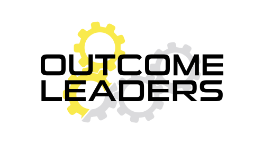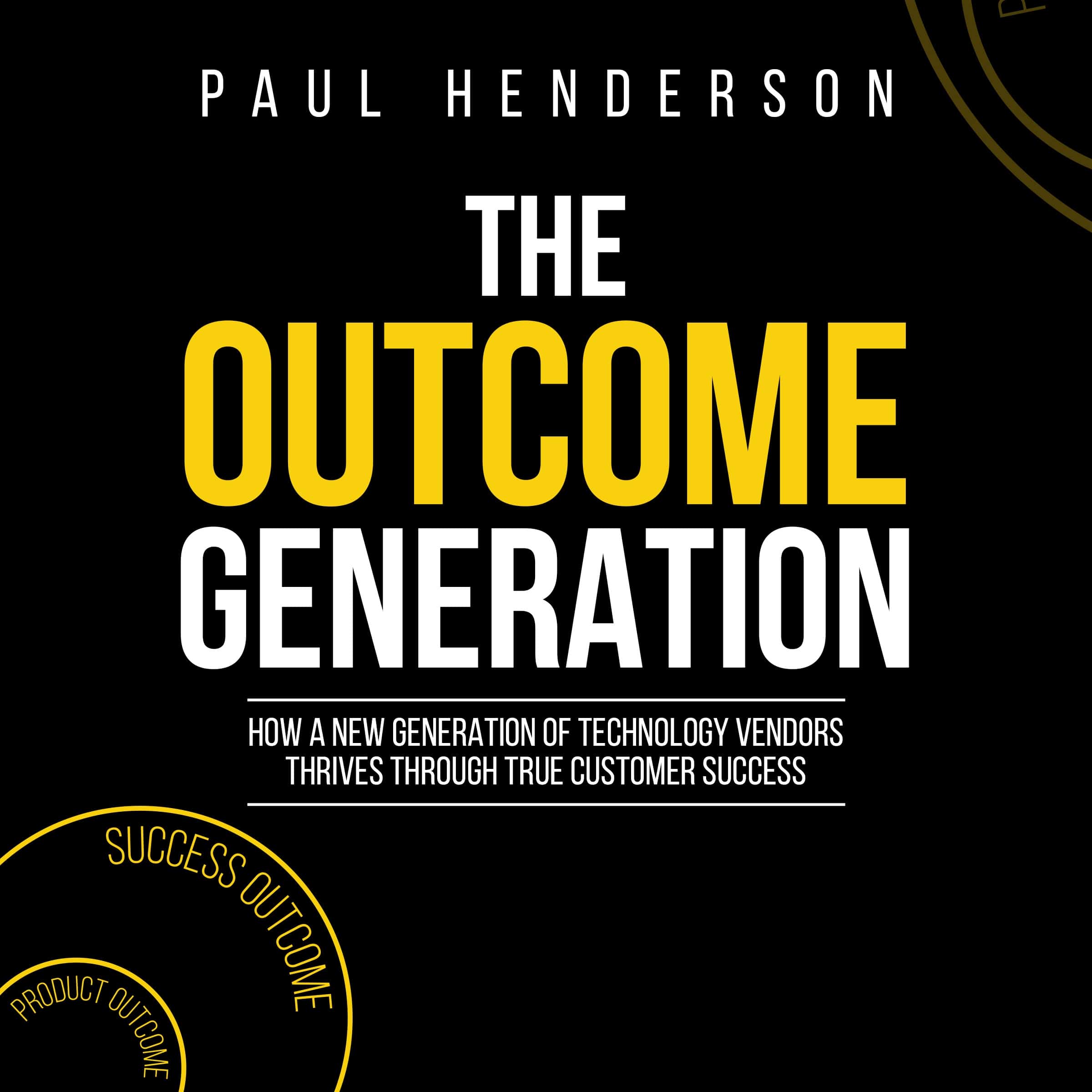
It’s hard developing the right engagement with every segment of our customers. We can use outcome lifecycles to simplify the process. And change the way we manage customer engagement.
And there’s one very simple idea that makes it all possible.
Why Do We Segment Our Customers?
It’s all about allocation of resources.
We can’t afford to devote the same amount of resource to every customer. Some customers pay us a large amount of money. We can afford to devote more resource to those customers. Some customers pay much less. If we want the smaller customers to be profitable, we must allocate less resource to each one. So, most technology companies segment based on the amount of revenue from each customer.
But revenue per customer isn’t the only factor. Others include the size of the customer (untapped potential), industry, geography, direct versus indirect (partner) relationship, government versus business and public versus private ownership.
An emerging segmentation considers how the customers want to engage with the vendor. Some customers seek only a transactional relationship. They’re happy to call when they need help. They expect the vendor to be available and to provide low prices. Other customers seek a deeper relationship. They call on the vendor’s expertise to help achieve their business objectives.
Factors influencing how we allocate resources to different segments include potential revenue, our expertise, our profitability, industry trends and our overall strategy.
What a Mess!
We have multiple segments and different considerations such as revenue potential, strategy etc. How do we develop the right lifecycle for each segment? It feels overwhelming!
Outcomes provide a framework for simplifying this process.
The Customer’s Cycle
A sensible starting place lies in understanding the cycle our customers go through. We start with a single high-level journey or cycle. The following diagram maps a common Customer Cycle. For an explanation of each step, see Appendix 1 of this article.
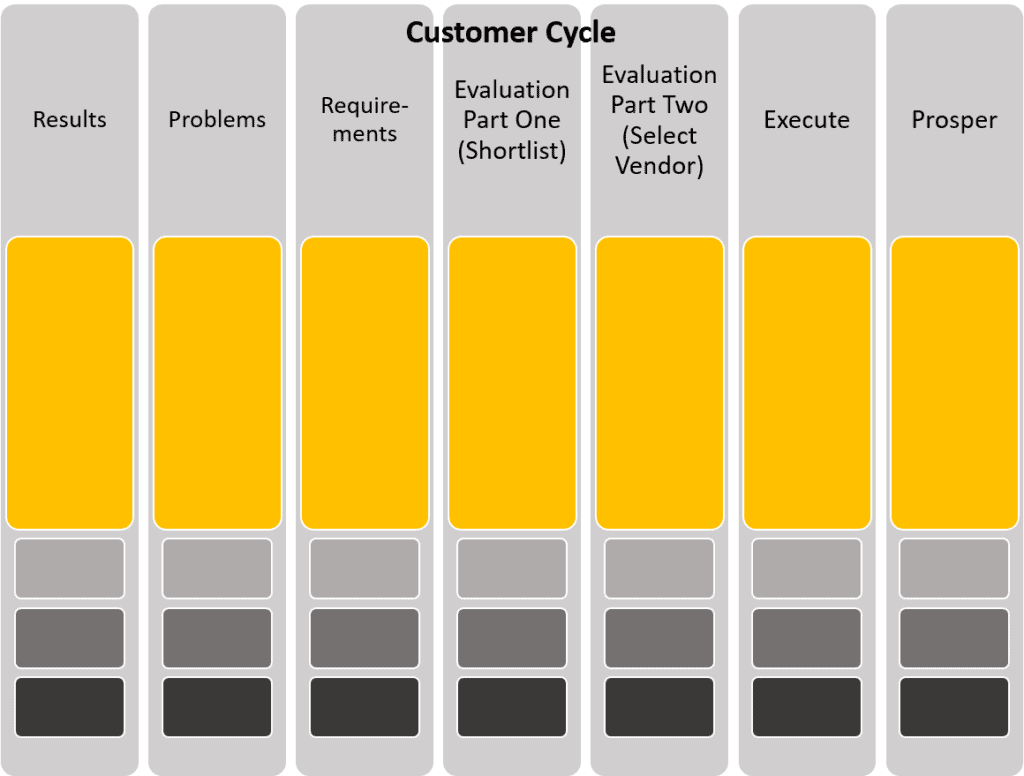
Engaging at Every Step of the Customer Cycle
Lots of technology vendors feel that engaging with new business (new logo) prospects is the job of Sales. But Sales doesn’t get involved until Evaluation Part Two in the customer cycle. That’s too late. The prospect has already made most of the decisions affecting whether they buy anything from the vendor.
Both Sales (Account Management) and Customer Success engage existing customers. But most customers don’t involve either of these groups in the early steps (Results/ Problems/ Requirements/ Evaluation-Part-One). The reason – vendors talk about products or solutions. But the customer doesn’t need information about the vendor’s product/solution until Evaluation Step Two. So, the customers don’t involve the vendor until Evaluation Step Two. Again, the customer has already made most of the decisions affecting whether they buy anything from the vendor. It’s too late to be engaging.
The vendor’s engagement lifecycle should engage the customer at every step of the Customer Cycle. And help the customer at every one of these steps. In the early steps, that means not talking about products or solutions.
The Next Step
Now that you have a Customer Cycle, should you develop customer lifecycles for each segment? Possibly. But there’s a step that will make the task easier and more effective.
You should define an Outcome Cycle.
Outcome-based Customer Lifecycle
For each step of the Customer Cycle, define the outcome you want to achieve. For example, if a customer executive analyses their results (step one of the Customer Cycle), what outcome would we like to happen?
Let’s map out some possible outcomes for each of the seven steps in the Customer Cycle. For an explanation of each outcome, see Appendix 2 of this article.
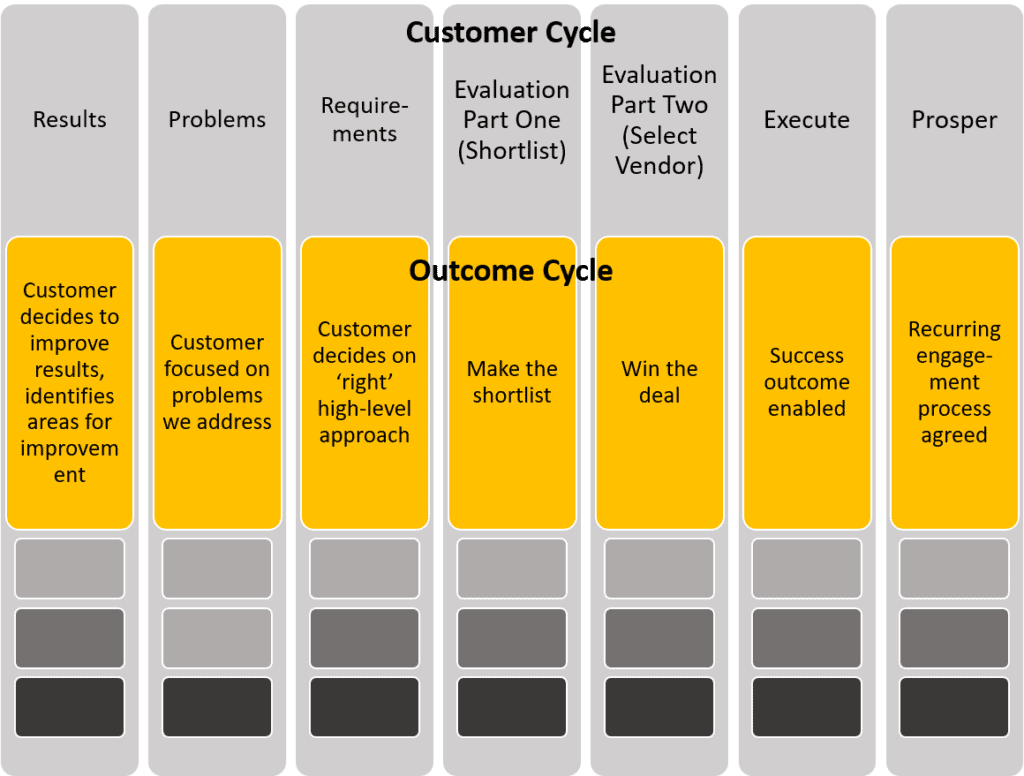
It’s now time to map the lifecycles we’ll follow for each segment. But why is this process now easier? How has the extra step of defining an Outcome Cycle helped?
The One Simple Idea
We’ll create a customer lifecycle for each segment. Each lifecycle will define how we’ll engage with customers in that segment. And each lifecycle will be different.
But the Customer Cycle remains the same for every segment. Customers will follow the same seven steps, regardless of how we engage with them. For example, step one (Results) will see an executive in the customer decide that results must improve. That will kick off a buying cycle. And that will happen in every segment we define.
And here’s the key thought. The outcome we want to achieve at each step of the Customer Cycle will be the same for every segment. The outcomes we want to achieve won’t vary by segment.
For example, in step one (Results), we’ll always want an outcome of ‘decision to improve results made, areas for improvement identified’. In every segment.
The Outcome Remains the Same, it’s the Execution that Varies
In the lifecycle for each segment, we’re now defining how we’ll achieve the outcome at each step. Lifecycles are about execution.
To illustrate, let’s use three segments of High Touch, Low Touch and Tech Touch. We’re defining the execution for step one (Results). For High Touch, we might use a Periodic Business Review to achieve the outcome. For Low Touch, we might have a lighter version of the Periodic Business review (fewer people, and less senior people on our side). For Tech Touch, we might provide data to the customer executives and give them a guide on how to identify the areas for improvement.
So, we’ll define a lifecycle for each segment. But in every segment, we’re defining how we’ll achieve the same outcome for that step.
Completing the Picture
We can now develop our lifecycles by segment, guided by the outcome to achieve at each step.
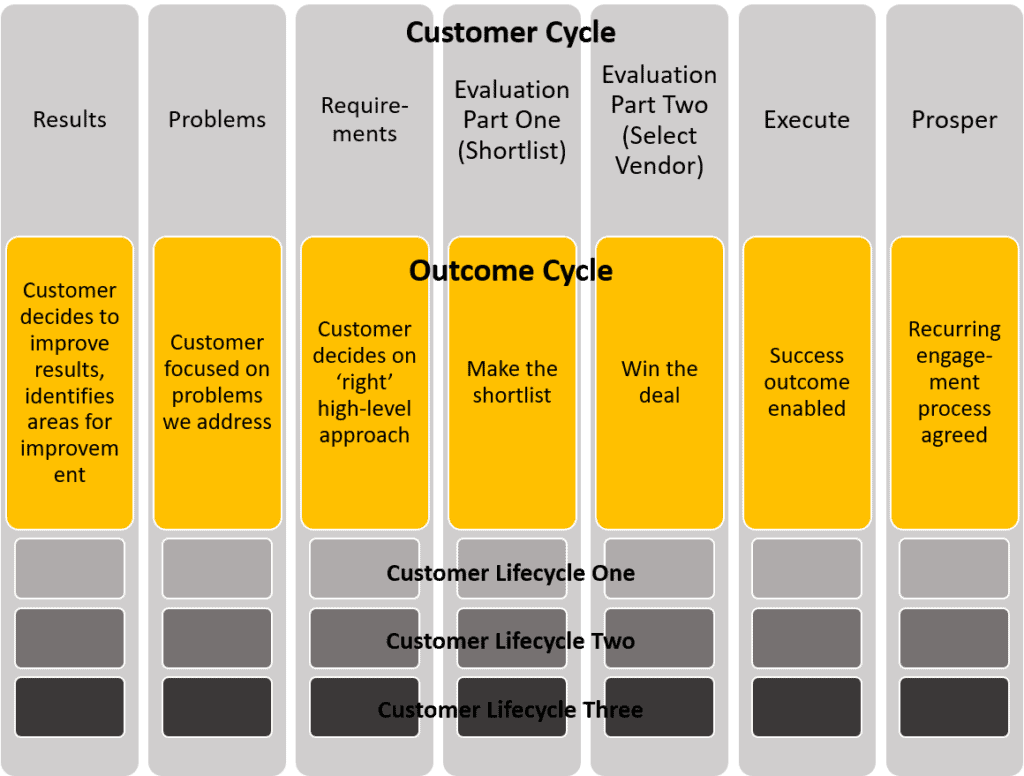
Another Benefit
Customer lifecycles tend to be driven by process. Vendor management asks everyone to follow the defined process. But being overly process-driven in customer engagement has a few problems. First, pre-defined processes don’t adapt quickly to changing circumstances. Second, they don’t allow for variations in customer situations. Third, they don’t encourage innovation.
Using Outcome-based Customer Lifecycles addresses these shortcomings.
Our staff focus on the outcome they need to enable. They’ll follow the normal process most of the time. But when a new circumstance arises, or the customer wants things done differently, the staff can readily adapt. They have a clear goal – achieve the outcome. As long as it’s achieved professionally, the ‘how’ is less important. And that makes the achievement of the outcome more likely.
Focusing on outcomes also encourages innovation. Staff may come up with better ways of achieving the outcome. And that’s great for everyone – the customer, vendor management and vendor staff.
Summary
There’s a cycle that our customers go through to buy technology. Our first step should be to define that cycle. We need clarity on what the customers do when they buy technology.
We want to engage the customer at every step of the Customer Cycle. If we don’t, customers will make decisions that have a big impact on what they buy without us having any influence.
Before we decide how we’ll engage, we should define the outcome we want to achieve at each step. When we’ve done this, we’ve defined an Outcome Cycle that matches the Customer Cycle.
We can then think about segmentation. We segment so we allocate our resources in the most effective way. We’ll engage with each segment differently – each will have a different customer lifecycle.
The great news is that the Customer Cycle and the Outcome Cycle remain the same across all segments. These give us the base from which we can design customer lifecycles. The lifecycles define how we’ll execute to achieve the outcome at each step.
And focusing on outcomes rather than process increases our ability to adapt to change or to different customer needs. It also increases the chance for innovation.
Next Steps
Map your Customer Cycle and Outcome Cycle.
Consider any customer lifecycles or customer journeys you already have. With the insight gained from clarity around the outcome at each step, would you change any of these lifecycles or customer journeys?
Appendix 1 – The Customer Cycle
Here’s a description of the seven steps in a common Customer Cycle.
Results
Before companies spend money on technology, an executive in the customer decides that results in an area of the business need to improve. This decision kicks off a buying cycle.
Problems/Roadblocks
The customer then considers the problems or roadblocks that might block achievement of the improved results.
Requirements
With an understanding of the results to achieve and the problems to overcome, the customer considers high-level approaches. They might consider buying technology, investing in external consulting, allocating internal resources et cetera. They’ll decide their high-level approach.
Evaluation Part One
If the customer’s high-level approach includes buying technology, they’ll research which vendors to consider. They don’t need to talk to vendors yet. There’s enough information online and through sources such as analysts. They’ll use this information to create a short list. Possibly a short list of one.
Evaluation Part Two
The evaluation process is well advanced before customers engage vendors. And the point at which they engage vendors is getting later and later in the buying cycle. The customers will be well-informed about the vendor’s offering and don’t need much education from the vendor. The customers want confirmation the vendor can deliver the results required. Upon completing their evaluation, they’ll choose a vendor and sign contracts.
Execution
The customer and vendor work together to execute a plan. The customer executive wants to achieve the improved business results that triggered this buying cycle. Sadly, the customer project team and the vendor often lose sight of that goal. They focus on product adoption – getting the vendor’s product working and used.
Prosper
Hopefully, the customer achieves the improved business results. But it’s rare that a customer will decide they’ve done enough. Most companies seek ongoing improvements in all aspects of business results. So, the buying cycle started when an executive decided results in an area needed to improve. A year later, that same executive might decide they’d like even better results.
A continuous improvement approach serves both customer and vendor well. They can both focus on continuing to improve the business results. And that’s a win-win. The customer enjoys better business results. And, usually, they’ll spend more with the vendor to achieve those better results.
Seven Steps
So, we can define a high-level cycle the customers go through in seven steps.
Appendix 2 – The Outcome Cycle
Here are possible outcomes associated with each step of the Customer Cycle.
Results
You want the customer executive to decide they need to improve an area of the business. And you want them to focus on areas of the business that lead to your products or services. This decision will kick off a buying cycle that could lead to a sale for you.
The outcome might be ‘Customer decides to improve results, identifies areas for improvement’.
Problems/Roadblocks
You’d like the customer to focus on problems or roadblocks you can help them address. The outcome might be ‘customer focused on problems we address’.
Requirements
You’d like them to adopt a high-level approach that leads them naturally to you. You’d like them to avoid approaches that might direct their expenditure elsewhere. For example, you don’t want them to spend money with an external consultant instead of buying your technology.
The outcome might be ‘customer decides on ‘right’ high-level approach’.
Evaluation Part One
Having decided on a high-level approach to buy technology, the customer is now considering what technology to buy. They’re developing a short-list. The outcome we want is ‘make the shortlist’.
Evaluation Part Two
Evaluation Part Two is a traditional sales process. We’ve made the short-list and are competing against other vendors. We’re also competing with a ‘do-nothing’ decision (often the toughest competitor we face). We need the customer to decide for us, and to commit to moving forward. The outcome will be ‘win the deal’.
Execution
In this phase, we’re helping the customer through our products and services. Of course, we must get our product working and adopted. But that’s not enough. Our primary focus should be enabling the improved business results the customer executive wants. That’s what he or she considers success to be. Let’s call that outcome a success outcome.
If the product works but the success outcome isn’t achieved, the customer executive will consider the project a failure. Even if it’s not our fault, that will cost us future revenue.
The outcome from this step should be ‘success outcome enabled’.
Prosper
Let’s assume the customer achieves the success outcome. The executive is happy…for now. But in a year (or less), they’ll want more improvement. We again want to take part in every step of the Customer Cycle. To do this, we want a recurring cycle of engagement agreed to by the customer. The joint focus is an ongoing improvement in the success outcome. We’ll develop a natural cycle of engagement which doesn’t have to be ‘sold’ every time.
The outcome might be ‘recurring engagement process agreed’.
Seven Steps
We can map both the Customer Cycle and the Outcome Cycle in seven steps.
This article is based on the book; The Outcome Generation: How a New Generation of Technology Vendors Thrives through True Customer Success
Paul Henderson is an author, speaker and consultant on outcome-based customer success for technology vendors. His last role was leading the Asia Pacific region of an enterprise software company. He saw the potential that could come from delivering real and measurable business success for customers. So, he initiated a customer success program based on customer outcomes. He and his colleagues developed, modified and proved the model over more than five years. He thespent one a half years researching and writing, culminating in the release of The Outcome Generation.
+61 1300-859791
pjh@outcomeleaders.com
facebook.com/outcomeleaders
linkedin.com/outcomeleaders
youtube.com/outcomeleaders
Receive the latest on Outcome-based Customer Success |
Send us a Message
Error: Contact form not found.
